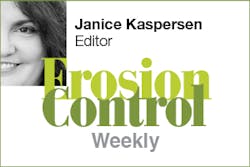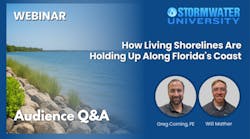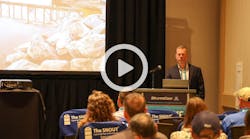
Do you ever have trouble explaining to people what it is you do on the job, or why it’s important? You probably know about World Soil Day—it’s December 5, in case you didn’t—which is an effort to increase awareness of the importance of soils and the need for conservation efforts and sustainable soil management. The United Nations has designated 2015 as the International Year of Soils. And an organization called the Global Soil Forum has widespread efforts underway to draw attention to the various issues surrounding soil, highlighting topics like food security, climate change (the GSF notes that the worldwide carbon stock in soils is 10 times greater than the carbon stock of forests), land governance, and urbanization.
Do you ever have trouble explaining to people what it is you do on the job, or why it’s important? You probably know about World Soil Day—it’s December 5, in case you didn’t—which is an effort to increase awareness of the importance of soils and the need for conservation efforts and sustainable soil management. The United Nations has designated 2015 as the International Year of Soils. And an organization called the Global Soil Forum has widespread efforts underway to draw attention to the various issues surrounding soil, highlighting topics like food security, climate change (the GSF notes that the worldwide carbon stock in soils is 10 times greater than the carbon stock of forests), land governance, and urbanization. [text_ad] The GSF website has a brief section titled “Why soils?” with some bite-sized facts and talking points. For example, since the since the 1950s, the amount of available arable land per capita has decreased by 50% worldwide. It takes about 500 years for the natural formation of just 2 centimeters of fertile topsoil. And worldwide, more than 24 billion tons of that fertile soil is lost through erosion. But perhaps the most useful tool, also available on the GSF site, is something called the Soil Atlas 2015. In 66 pages and 28 brief chapters, it covers a whole range of issues, with helpful graphics and maps. For example, there is a detailed breakdown of the microorganisms found in healthy soil; a map showing the types of soils (i.e., high-clay content soil; heavily weathered, well-draining soil; volcanic soil; oxygen-deficient soil) in various parts of the world and the implications for agriculture in each region; another map showing the major threats to agriculture around the world (pollution, erosion, deforestation, desertification, and so on); examples of good and bad agricultural practices; fertilizer use in different regions; and how much carbon is sequestered in different ecosystems (forest, grassland, tundra, marshland, etc.). There is lots of information here—some more relevant to erosion control practices than others, and some of which you might not agree with—and, with its colorful and easy-to-understand graphics, I can see this as a good resource for a classroom module on soils or simply as a reference to direct people who are curious about your work. You can download the Soil Atlas for free here. StormCon Call for Papers Is Open StormCon, the only North American event dedicated exclusively to stormwater and surface-water professionals, is seeking abstracts for presentation at StormCon 2016. The deadline for submitting abstracts is Wednesday, December 9. The conference will be held in Indianapolis, IN, August 22–25, 2016. We are looking for abstracts in the following conference tracks:BMP Case Studies
Green Infrastructure
Stormwater Program Management
Advanced Research Topics
Water-Quality Monitoring
Industrial Stormwater Management
Stormwater Management for Solid Waste Facilities
For more information, including the complete call for papers and an online form for submitting your abstract, visit www.StormCon.com.The GSF website has a brief section titled “Why soils?” with some bite-sized facts and talking points. For example, since the since the 1950s, the amount of available arable land per capita has decreased by 50% worldwide. It takes about 500 years for the natural formation of just 2 centimeters of fertile topsoil. And worldwide, more than 24 billion tons of that fertile soil is lost through erosion.
But perhaps the most useful tool, also available on the GSF site, is something called the Soil Atlas 2015. In 66 pages and 28 brief chapters, it covers a whole range of issues, with helpful graphics and maps. For example, there is a detailed breakdown of the microorganisms found in healthy soil; a map showing the types of soils (i.e., high-clay content soil; heavily weathered, well-draining soil; volcanic soil; oxygen-deficient soil) in various parts of the world and the implications for agriculture in each region; another map showing the major threats to agriculture around the world (pollution, erosion, deforestation, desertification, and so on); examples of good and bad agricultural practices; fertilizer use in different regions; and how much carbon is sequestered in different ecosystems (forest, grassland, tundra, marshland, etc.).
There is lots of information here—some more relevant to erosion control practices than others, and some of which you might not agree with—and, with its colorful and easy-to-understand graphics, I can see this as a good resource for a classroom module on soils or simply as a reference to direct people who are curious about your work. You can download the Soil Atlas for free here.
StormCon Call for Papers Is Open
StormCon, the only North American event dedicated exclusively to stormwater and surface-water professionals, is seeking abstracts for presentation at StormCon 2016. The deadline for submitting abstracts is Wednesday, December 9.
The conference will be held in Indianapolis, IN, August 22–25, 2016. We are looking for abstracts in the following conference tracks:
BMP Case Studies
Green Infrastructure
Stormwater Program Management
Advanced Research Topics
Water-Quality Monitoring
Industrial Stormwater Management
Stormwater Management for Solid Waste Facilities
For more information, including the complete call for papers and an online form for submitting your abstract, visit www.StormCon.com.About the Author
Janice Kaspersen
Janice Kaspersen is the former editor of Erosion Control and Stormwater magazines.


